Analysis of Amazon's Organizational Strategy and Leadership Approach
VerifiedAdded on 2023/02/01
|21
|5079
|87
Report
AI Summary
This report provides a comprehensive analysis of Amazon's organizational strategy and leadership. It begins with an abstract summarizing the key aspects of Amazon's success, emphasizing the role of strategic management and leadership qualities. The introduction offers a brief history of Amazon, highlighting its evolution from an online bookstore to a diverse "everything store." The report then delves into Amazon's generic business strategies, focusing on cost leadership and differentiation. Cost leadership is examined through Amazon's use of technology, R&D, and supply chain management to reduce operational costs. The differentiation strategy discusses how Amazon attains uniqueness through product design, technological features, and brand image. The report also explores Amazon's organizational culture, identifying both adhocracy and hierarchical elements. It highlights characteristics such as boldness, customer-centricity, and peculiarity. The report concludes by emphasizing how Amazon's culture, supported by the ASA theory, contributes to its rapid global development and competitive advantage.
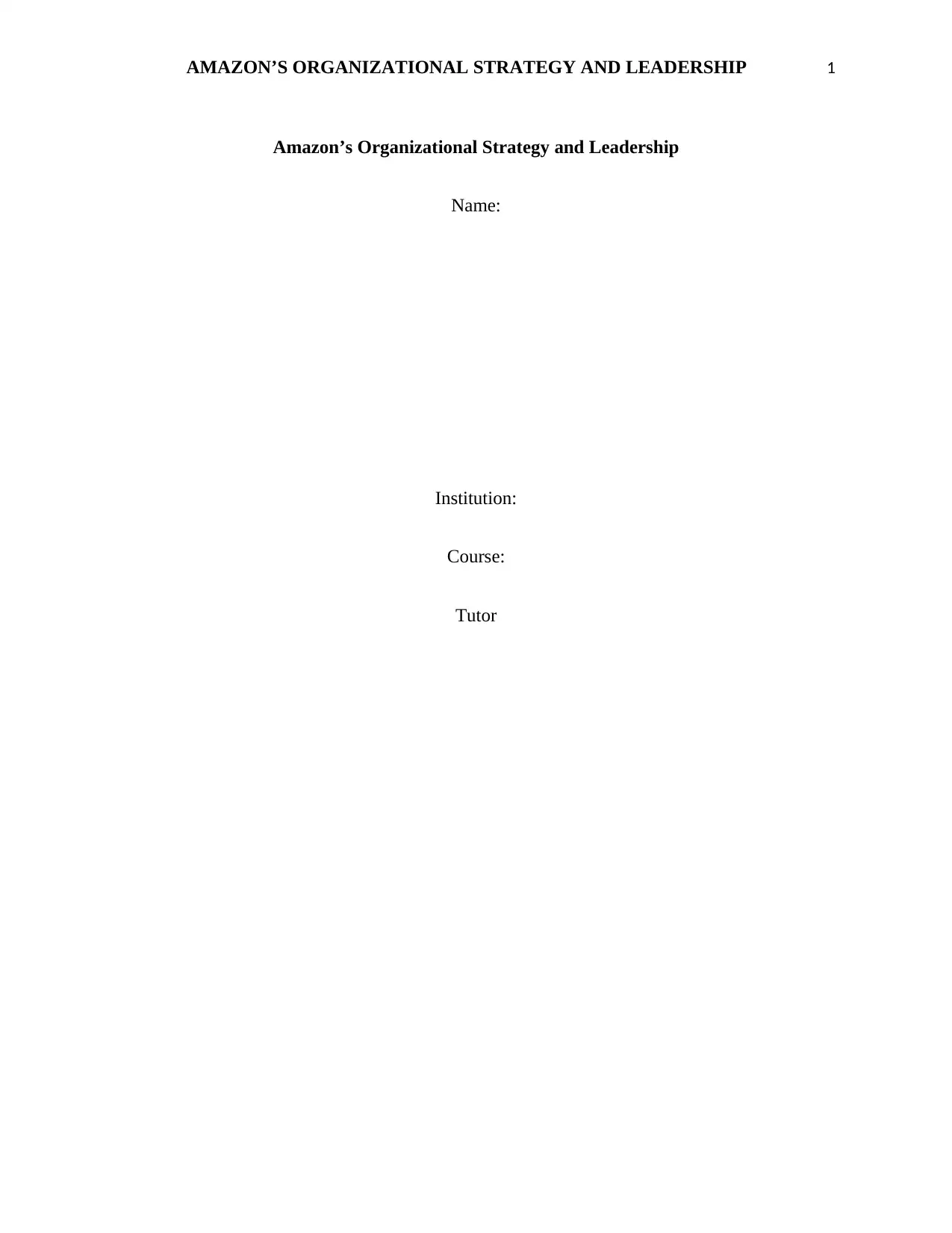
AMAZON’S ORGANIZATIONAL STRATEGY AND LEADERSHIP 1
Amazon’s Organizational Strategy and Leadership
Name:
Institution:
Course:
Tutor
Amazon’s Organizational Strategy and Leadership
Name:
Institution:
Course:
Tutor
Paraphrase This Document
Need a fresh take? Get an instant paraphrase of this document with our AI Paraphraser
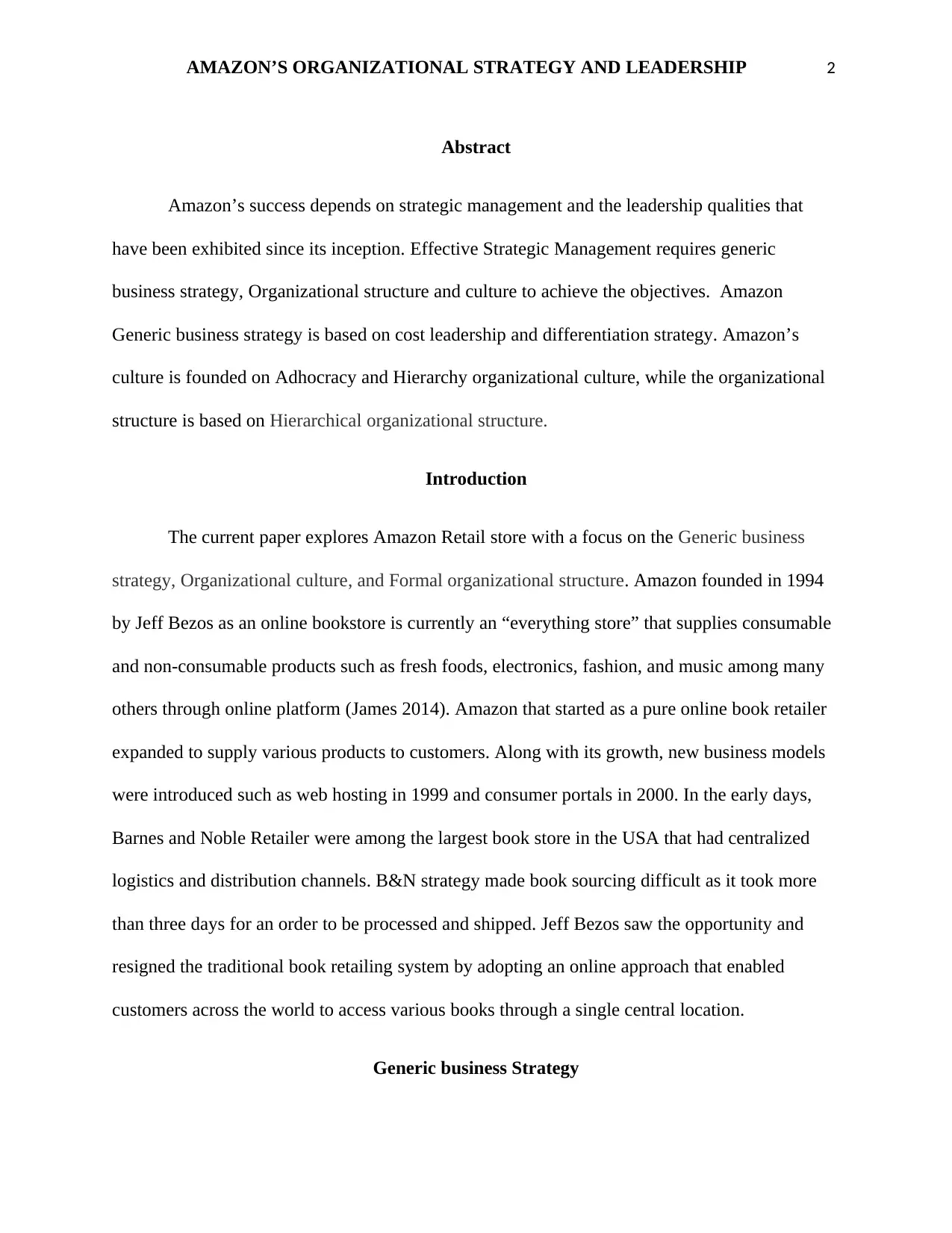
AMAZON’S ORGANIZATIONAL STRATEGY AND LEADERSHIP 2
Abstract
Amazon’s success depends on strategic management and the leadership qualities that
have been exhibited since its inception. Effective Strategic Management requires generic
business strategy, Organizational structure and culture to achieve the objectives. Amazon
Generic business strategy is based on cost leadership and differentiation strategy. Amazon’s
culture is founded on Adhocracy and Hierarchy organizational culture, while the organizational
structure is based on Hierarchical organizational structure.
Introduction
The current paper explores Amazon Retail store with a focus on the Generic business
strategy, Organizational culture, and Formal organizational structure. Amazon founded in 1994
by Jeff Bezos as an online bookstore is currently an “everything store” that supplies consumable
and non-consumable products such as fresh foods, electronics, fashion, and music among many
others through online platform (James 2014). Amazon that started as a pure online book retailer
expanded to supply various products to customers. Along with its growth, new business models
were introduced such as web hosting in 1999 and consumer portals in 2000. In the early days,
Barnes and Noble Retailer were among the largest book store in the USA that had centralized
logistics and distribution channels. B&N strategy made book sourcing difficult as it took more
than three days for an order to be processed and shipped. Jeff Bezos saw the opportunity and
resigned the traditional book retailing system by adopting an online approach that enabled
customers across the world to access various books through a single central location.
Generic business Strategy
Abstract
Amazon’s success depends on strategic management and the leadership qualities that
have been exhibited since its inception. Effective Strategic Management requires generic
business strategy, Organizational structure and culture to achieve the objectives. Amazon
Generic business strategy is based on cost leadership and differentiation strategy. Amazon’s
culture is founded on Adhocracy and Hierarchy organizational culture, while the organizational
structure is based on Hierarchical organizational structure.
Introduction
The current paper explores Amazon Retail store with a focus on the Generic business
strategy, Organizational culture, and Formal organizational structure. Amazon founded in 1994
by Jeff Bezos as an online bookstore is currently an “everything store” that supplies consumable
and non-consumable products such as fresh foods, electronics, fashion, and music among many
others through online platform (James 2014). Amazon that started as a pure online book retailer
expanded to supply various products to customers. Along with its growth, new business models
were introduced such as web hosting in 1999 and consumer portals in 2000. In the early days,
Barnes and Noble Retailer were among the largest book store in the USA that had centralized
logistics and distribution channels. B&N strategy made book sourcing difficult as it took more
than three days for an order to be processed and shipped. Jeff Bezos saw the opportunity and
resigned the traditional book retailing system by adopting an online approach that enabled
customers across the world to access various books through a single central location.
Generic business Strategy
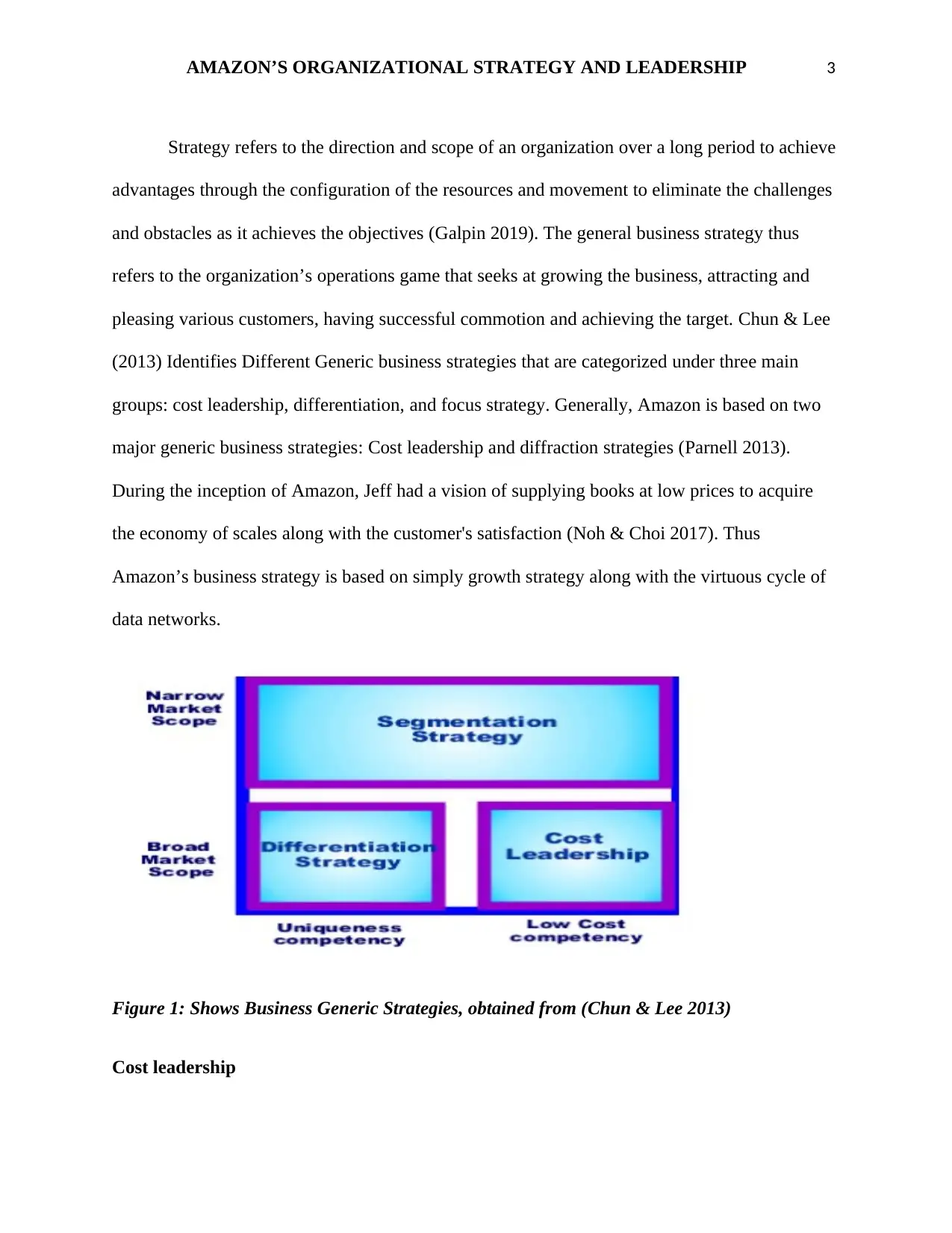
AMAZON’S ORGANIZATIONAL STRATEGY AND LEADERSHIP 3
Strategy refers to the direction and scope of an organization over a long period to achieve
advantages through the configuration of the resources and movement to eliminate the challenges
and obstacles as it achieves the objectives (Galpin 2019). The general business strategy thus
refers to the organization’s operations game that seeks at growing the business, attracting and
pleasing various customers, having successful commotion and achieving the target. Chun & Lee
(2013) Identifies Different Generic business strategies that are categorized under three main
groups: cost leadership, differentiation, and focus strategy. Generally, Amazon is based on two
major generic business strategies: Cost leadership and diffraction strategies (Parnell 2013).
During the inception of Amazon, Jeff had a vision of supplying books at low prices to acquire
the economy of scales along with the customer's satisfaction (Noh & Choi 2017). Thus
Amazon’s business strategy is based on simply growth strategy along with the virtuous cycle of
data networks.
Figure 1: Shows Business Generic Strategies, obtained from (Chun & Lee 2013)
Cost leadership
Strategy refers to the direction and scope of an organization over a long period to achieve
advantages through the configuration of the resources and movement to eliminate the challenges
and obstacles as it achieves the objectives (Galpin 2019). The general business strategy thus
refers to the organization’s operations game that seeks at growing the business, attracting and
pleasing various customers, having successful commotion and achieving the target. Chun & Lee
(2013) Identifies Different Generic business strategies that are categorized under three main
groups: cost leadership, differentiation, and focus strategy. Generally, Amazon is based on two
major generic business strategies: Cost leadership and diffraction strategies (Parnell 2013).
During the inception of Amazon, Jeff had a vision of supplying books at low prices to acquire
the economy of scales along with the customer's satisfaction (Noh & Choi 2017). Thus
Amazon’s business strategy is based on simply growth strategy along with the virtuous cycle of
data networks.
Figure 1: Shows Business Generic Strategies, obtained from (Chun & Lee 2013)
Cost leadership
⊘ This is a preview!⊘
Do you want full access?
Subscribe today to unlock all pages.

Trusted by 1+ million students worldwide
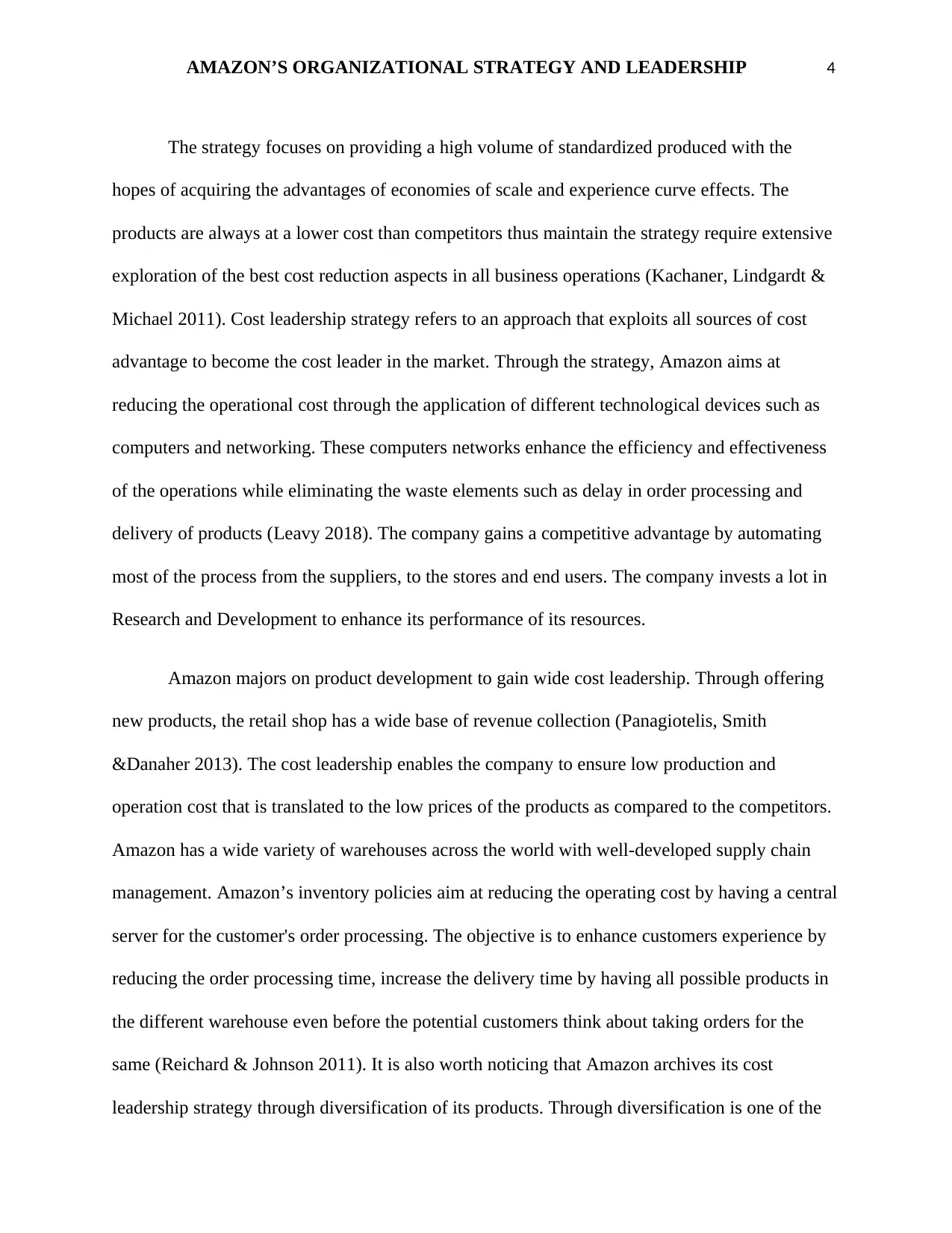
AMAZON’S ORGANIZATIONAL STRATEGY AND LEADERSHIP 4
The strategy focuses on providing a high volume of standardized produced with the
hopes of acquiring the advantages of economies of scale and experience curve effects. The
products are always at a lower cost than competitors thus maintain the strategy require extensive
exploration of the best cost reduction aspects in all business operations (Kachaner, Lindgardt &
Michael 2011). Cost leadership strategy refers to an approach that exploits all sources of cost
advantage to become the cost leader in the market. Through the strategy, Amazon aims at
reducing the operational cost through the application of different technological devices such as
computers and networking. These computers networks enhance the efficiency and effectiveness
of the operations while eliminating the waste elements such as delay in order processing and
delivery of products (Leavy 2018). The company gains a competitive advantage by automating
most of the process from the suppliers, to the stores and end users. The company invests a lot in
Research and Development to enhance its performance of its resources.
Amazon majors on product development to gain wide cost leadership. Through offering
new products, the retail shop has a wide base of revenue collection (Panagiotelis, Smith
&Danaher 2013). The cost leadership enables the company to ensure low production and
operation cost that is translated to the low prices of the products as compared to the competitors.
Amazon has a wide variety of warehouses across the world with well-developed supply chain
management. Amazon’s inventory policies aim at reducing the operating cost by having a central
server for the customer's order processing. The objective is to enhance customers experience by
reducing the order processing time, increase the delivery time by having all possible products in
the different warehouse even before the potential customers think about taking orders for the
same (Reichard & Johnson 2011). It is also worth noticing that Amazon archives its cost
leadership strategy through diversification of its products. Through diversification is one of the
The strategy focuses on providing a high volume of standardized produced with the
hopes of acquiring the advantages of economies of scale and experience curve effects. The
products are always at a lower cost than competitors thus maintain the strategy require extensive
exploration of the best cost reduction aspects in all business operations (Kachaner, Lindgardt &
Michael 2011). Cost leadership strategy refers to an approach that exploits all sources of cost
advantage to become the cost leader in the market. Through the strategy, Amazon aims at
reducing the operational cost through the application of different technological devices such as
computers and networking. These computers networks enhance the efficiency and effectiveness
of the operations while eliminating the waste elements such as delay in order processing and
delivery of products (Leavy 2018). The company gains a competitive advantage by automating
most of the process from the suppliers, to the stores and end users. The company invests a lot in
Research and Development to enhance its performance of its resources.
Amazon majors on product development to gain wide cost leadership. Through offering
new products, the retail shop has a wide base of revenue collection (Panagiotelis, Smith
&Danaher 2013). The cost leadership enables the company to ensure low production and
operation cost that is translated to the low prices of the products as compared to the competitors.
Amazon has a wide variety of warehouses across the world with well-developed supply chain
management. Amazon’s inventory policies aim at reducing the operating cost by having a central
server for the customer's order processing. The objective is to enhance customers experience by
reducing the order processing time, increase the delivery time by having all possible products in
the different warehouse even before the potential customers think about taking orders for the
same (Reichard & Johnson 2011). It is also worth noticing that Amazon archives its cost
leadership strategy through diversification of its products. Through diversification is one of the
Paraphrase This Document
Need a fresh take? Get an instant paraphrase of this document with our AI Paraphraser
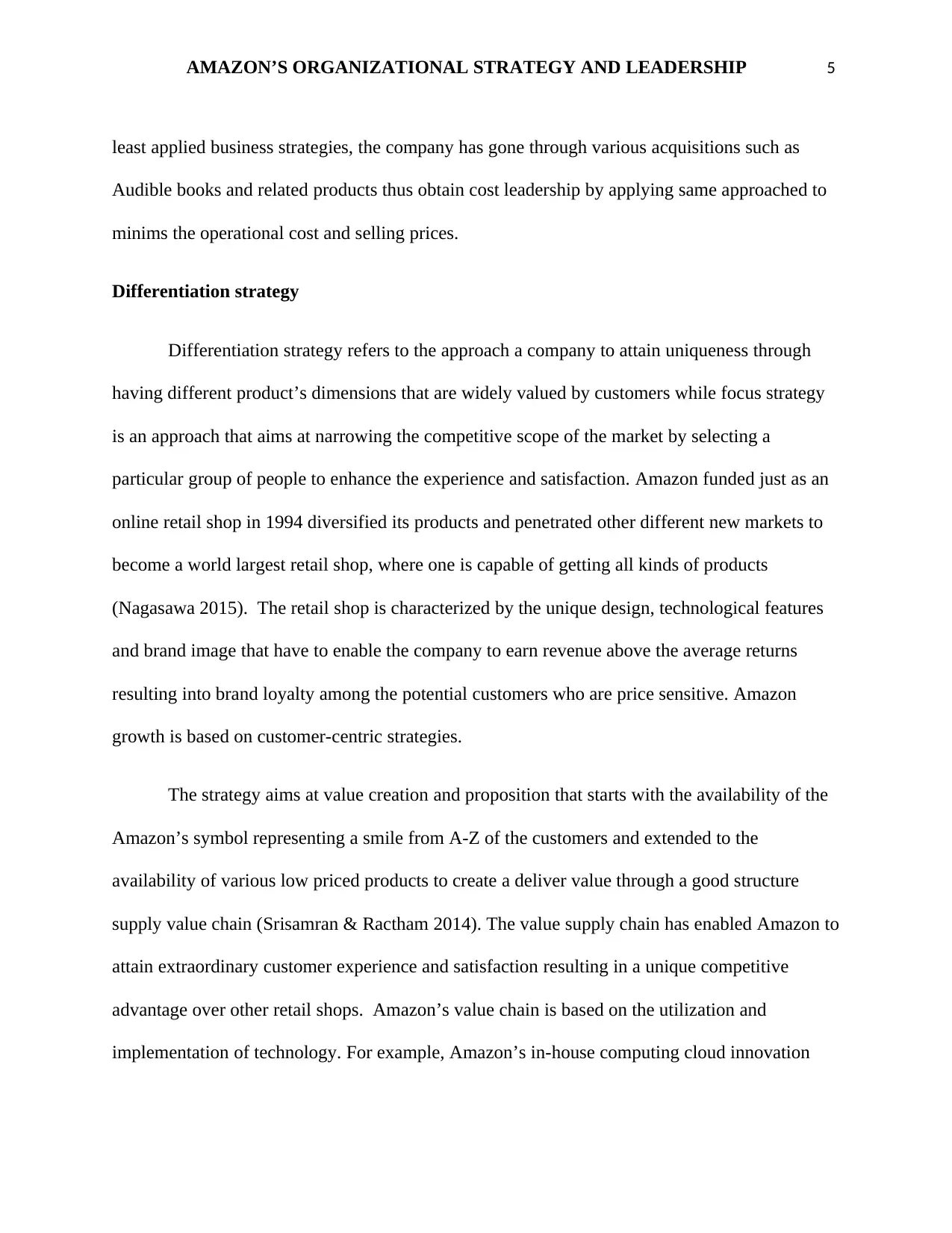
AMAZON’S ORGANIZATIONAL STRATEGY AND LEADERSHIP 5
least applied business strategies, the company has gone through various acquisitions such as
Audible books and related products thus obtain cost leadership by applying same approached to
minims the operational cost and selling prices.
Differentiation strategy
Differentiation strategy refers to the approach a company to attain uniqueness through
having different product’s dimensions that are widely valued by customers while focus strategy
is an approach that aims at narrowing the competitive scope of the market by selecting a
particular group of people to enhance the experience and satisfaction. Amazon funded just as an
online retail shop in 1994 diversified its products and penetrated other different new markets to
become a world largest retail shop, where one is capable of getting all kinds of products
(Nagasawa 2015). The retail shop is characterized by the unique design, technological features
and brand image that have to enable the company to earn revenue above the average returns
resulting into brand loyalty among the potential customers who are price sensitive. Amazon
growth is based on customer-centric strategies.
The strategy aims at value creation and proposition that starts with the availability of the
Amazon’s symbol representing a smile from A-Z of the customers and extended to the
availability of various low priced products to create a deliver value through a good structure
supply value chain (Srisamran & Ractham 2014). The value supply chain has enabled Amazon to
attain extraordinary customer experience and satisfaction resulting in a unique competitive
advantage over other retail shops. Amazon’s value chain is based on the utilization and
implementation of technology. For example, Amazon’s in-house computing cloud innovation
least applied business strategies, the company has gone through various acquisitions such as
Audible books and related products thus obtain cost leadership by applying same approached to
minims the operational cost and selling prices.
Differentiation strategy
Differentiation strategy refers to the approach a company to attain uniqueness through
having different product’s dimensions that are widely valued by customers while focus strategy
is an approach that aims at narrowing the competitive scope of the market by selecting a
particular group of people to enhance the experience and satisfaction. Amazon funded just as an
online retail shop in 1994 diversified its products and penetrated other different new markets to
become a world largest retail shop, where one is capable of getting all kinds of products
(Nagasawa 2015). The retail shop is characterized by the unique design, technological features
and brand image that have to enable the company to earn revenue above the average returns
resulting into brand loyalty among the potential customers who are price sensitive. Amazon
growth is based on customer-centric strategies.
The strategy aims at value creation and proposition that starts with the availability of the
Amazon’s symbol representing a smile from A-Z of the customers and extended to the
availability of various low priced products to create a deliver value through a good structure
supply value chain (Srisamran & Ractham 2014). The value supply chain has enabled Amazon to
attain extraordinary customer experience and satisfaction resulting in a unique competitive
advantage over other retail shops. Amazon’s value chain is based on the utilization and
implementation of technology. For example, Amazon’s in-house computing cloud innovation
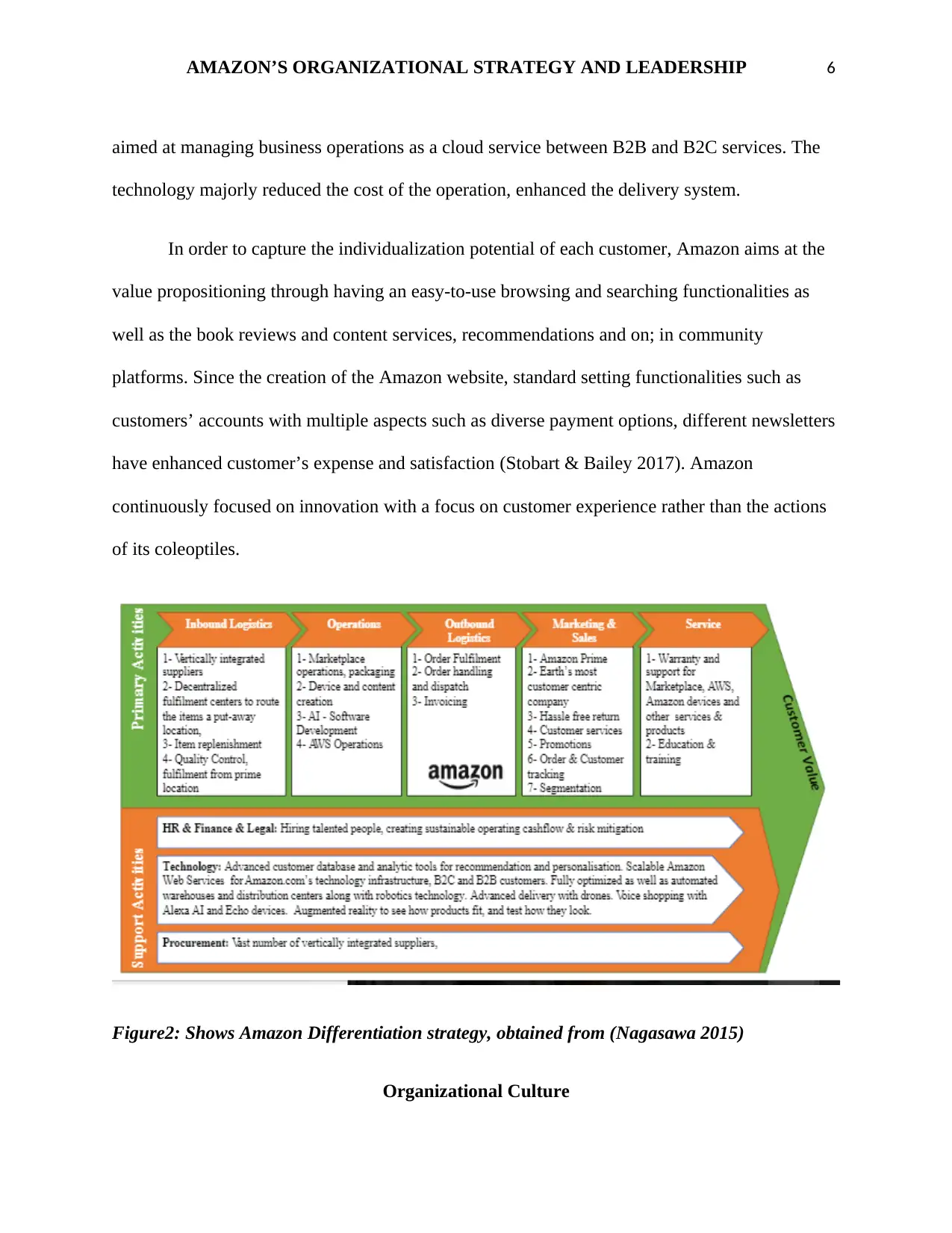
AMAZON’S ORGANIZATIONAL STRATEGY AND LEADERSHIP 6
aimed at managing business operations as a cloud service between B2B and B2C services. The
technology majorly reduced the cost of the operation, enhanced the delivery system.
In order to capture the individualization potential of each customer, Amazon aims at the
value propositioning through having an easy-to-use browsing and searching functionalities as
well as the book reviews and content services, recommendations and on; in community
platforms. Since the creation of the Amazon website, standard setting functionalities such as
customers’ accounts with multiple aspects such as diverse payment options, different newsletters
have enhanced customer’s expense and satisfaction (Stobart & Bailey 2017). Amazon
continuously focused on innovation with a focus on customer experience rather than the actions
of its coleoptiles.
Figure2: Shows Amazon Differentiation strategy, obtained from (Nagasawa 2015)
Organizational Culture
aimed at managing business operations as a cloud service between B2B and B2C services. The
technology majorly reduced the cost of the operation, enhanced the delivery system.
In order to capture the individualization potential of each customer, Amazon aims at the
value propositioning through having an easy-to-use browsing and searching functionalities as
well as the book reviews and content services, recommendations and on; in community
platforms. Since the creation of the Amazon website, standard setting functionalities such as
customers’ accounts with multiple aspects such as diverse payment options, different newsletters
have enhanced customer’s expense and satisfaction (Stobart & Bailey 2017). Amazon
continuously focused on innovation with a focus on customer experience rather than the actions
of its coleoptiles.
Figure2: Shows Amazon Differentiation strategy, obtained from (Nagasawa 2015)
Organizational Culture
⊘ This is a preview!⊘
Do you want full access?
Subscribe today to unlock all pages.

Trusted by 1+ million students worldwide
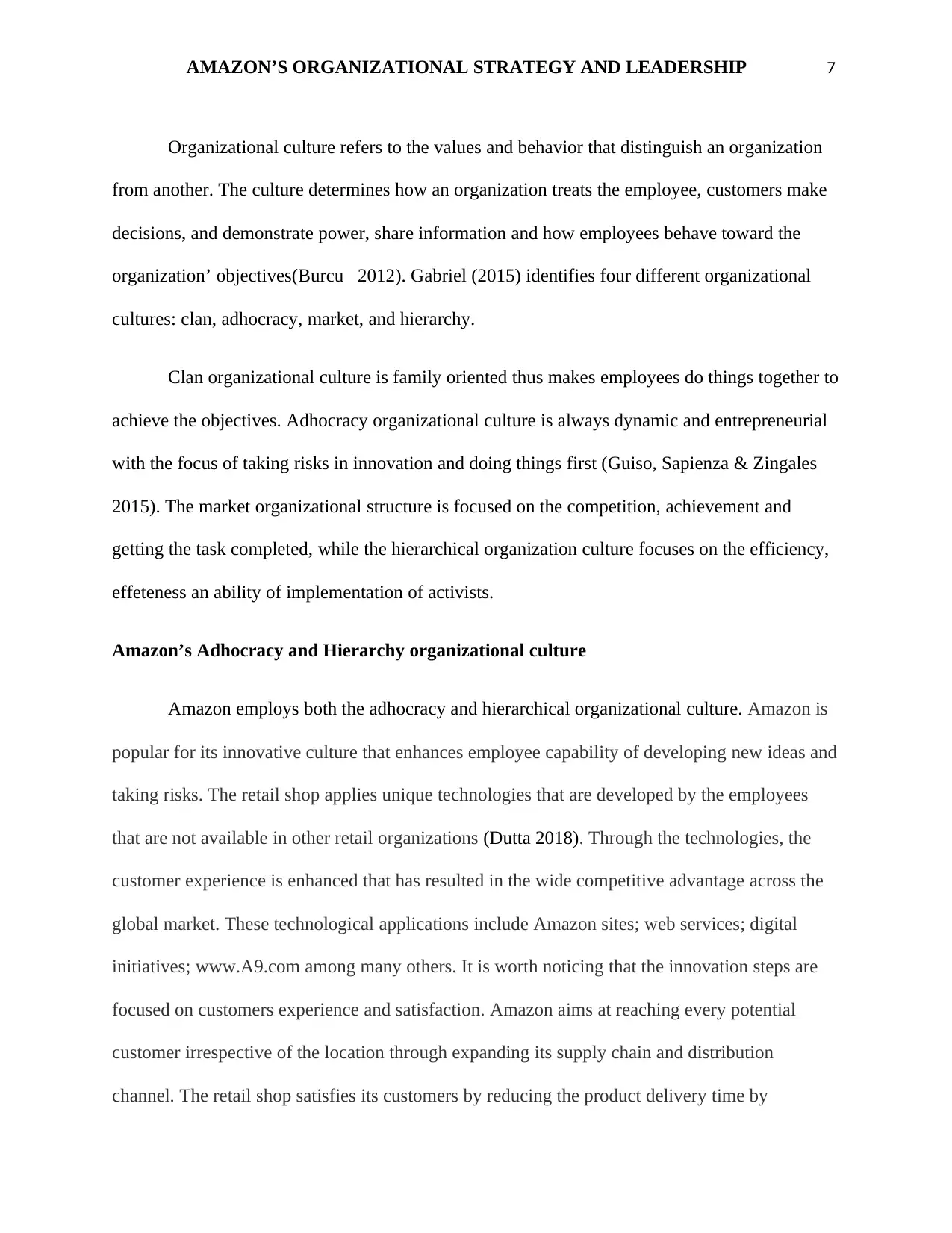
AMAZON’S ORGANIZATIONAL STRATEGY AND LEADERSHIP 7
Organizational culture refers to the values and behavior that distinguish an organization
from another. The culture determines how an organization treats the employee, customers make
decisions, and demonstrate power, share information and how employees behave toward the
organization’ objectives(Burcu 2012). Gabriel (2015) identifies four different organizational
cultures: clan, adhocracy, market, and hierarchy.
Clan organizational culture is family oriented thus makes employees do things together to
achieve the objectives. Adhocracy organizational culture is always dynamic and entrepreneurial
with the focus of taking risks in innovation and doing things first (Guiso, Sapienza & Zingales
2015). The market organizational structure is focused on the competition, achievement and
getting the task completed, while the hierarchical organization culture focuses on the efficiency,
effeteness an ability of implementation of activists.
Amazon’s Adhocracy and Hierarchy organizational culture
Amazon employs both the adhocracy and hierarchical organizational culture. Amazon is
popular for its innovative culture that enhances employee capability of developing new ideas and
taking risks. The retail shop applies unique technologies that are developed by the employees
that are not available in other retail organizations (Dutta 2018). Through the technologies, the
customer experience is enhanced that has resulted in the wide competitive advantage across the
global market. These technological applications include Amazon sites; web services; digital
initiatives; www.A9.com among many others. It is worth noticing that the innovation steps are
focused on customers experience and satisfaction. Amazon aims at reaching every potential
customer irrespective of the location through expanding its supply chain and distribution
channel. The retail shop satisfies its customers by reducing the product delivery time by
Organizational culture refers to the values and behavior that distinguish an organization
from another. The culture determines how an organization treats the employee, customers make
decisions, and demonstrate power, share information and how employees behave toward the
organization’ objectives(Burcu 2012). Gabriel (2015) identifies four different organizational
cultures: clan, adhocracy, market, and hierarchy.
Clan organizational culture is family oriented thus makes employees do things together to
achieve the objectives. Adhocracy organizational culture is always dynamic and entrepreneurial
with the focus of taking risks in innovation and doing things first (Guiso, Sapienza & Zingales
2015). The market organizational structure is focused on the competition, achievement and
getting the task completed, while the hierarchical organization culture focuses on the efficiency,
effeteness an ability of implementation of activists.
Amazon’s Adhocracy and Hierarchy organizational culture
Amazon employs both the adhocracy and hierarchical organizational culture. Amazon is
popular for its innovative culture that enhances employee capability of developing new ideas and
taking risks. The retail shop applies unique technologies that are developed by the employees
that are not available in other retail organizations (Dutta 2018). Through the technologies, the
customer experience is enhanced that has resulted in the wide competitive advantage across the
global market. These technological applications include Amazon sites; web services; digital
initiatives; www.A9.com among many others. It is worth noticing that the innovation steps are
focused on customers experience and satisfaction. Amazon aims at reaching every potential
customer irrespective of the location through expanding its supply chain and distribution
channel. The retail shop satisfies its customers by reducing the product delivery time by
Paraphrase This Document
Need a fresh take? Get an instant paraphrase of this document with our AI Paraphraser
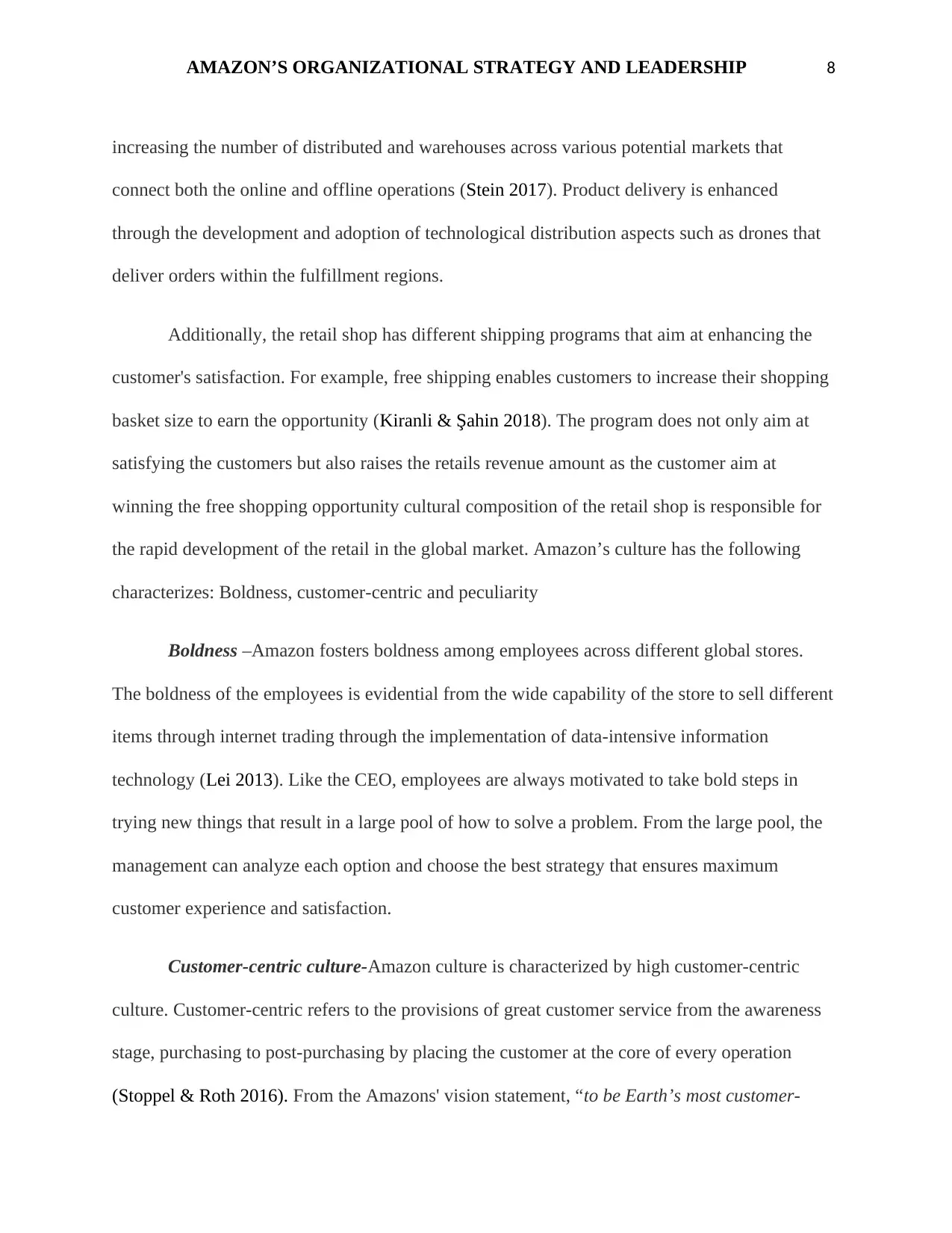
AMAZON’S ORGANIZATIONAL STRATEGY AND LEADERSHIP 8
increasing the number of distributed and warehouses across various potential markets that
connect both the online and offline operations (Stein 2017). Product delivery is enhanced
through the development and adoption of technological distribution aspects such as drones that
deliver orders within the fulfillment regions.
Additionally, the retail shop has different shipping programs that aim at enhancing the
customer's satisfaction. For example, free shipping enables customers to increase their shopping
basket size to earn the opportunity (Kiranli & Şahin 2018). The program does not only aim at
satisfying the customers but also raises the retails revenue amount as the customer aim at
winning the free shopping opportunity cultural composition of the retail shop is responsible for
the rapid development of the retail in the global market. Amazon’s culture has the following
characterizes: Boldness, customer-centric and peculiarity
Boldness –Amazon fosters boldness among employees across different global stores.
The boldness of the employees is evidential from the wide capability of the store to sell different
items through internet trading through the implementation of data-intensive information
technology (Lei 2013). Like the CEO, employees are always motivated to take bold steps in
trying new things that result in a large pool of how to solve a problem. From the large pool, the
management can analyze each option and choose the best strategy that ensures maximum
customer experience and satisfaction.
Customer-centric culture-Amazon culture is characterized by high customer-centric
culture. Customer-centric refers to the provisions of great customer service from the awareness
stage, purchasing to post-purchasing by placing the customer at the core of every operation
(Stoppel & Roth 2016). From the Amazons' vision statement, “to be Earth’s most customer-
increasing the number of distributed and warehouses across various potential markets that
connect both the online and offline operations (Stein 2017). Product delivery is enhanced
through the development and adoption of technological distribution aspects such as drones that
deliver orders within the fulfillment regions.
Additionally, the retail shop has different shipping programs that aim at enhancing the
customer's satisfaction. For example, free shipping enables customers to increase their shopping
basket size to earn the opportunity (Kiranli & Şahin 2018). The program does not only aim at
satisfying the customers but also raises the retails revenue amount as the customer aim at
winning the free shopping opportunity cultural composition of the retail shop is responsible for
the rapid development of the retail in the global market. Amazon’s culture has the following
characterizes: Boldness, customer-centric and peculiarity
Boldness –Amazon fosters boldness among employees across different global stores.
The boldness of the employees is evidential from the wide capability of the store to sell different
items through internet trading through the implementation of data-intensive information
technology (Lei 2013). Like the CEO, employees are always motivated to take bold steps in
trying new things that result in a large pool of how to solve a problem. From the large pool, the
management can analyze each option and choose the best strategy that ensures maximum
customer experience and satisfaction.
Customer-centric culture-Amazon culture is characterized by high customer-centric
culture. Customer-centric refers to the provisions of great customer service from the awareness
stage, purchasing to post-purchasing by placing the customer at the core of every operation
(Stoppel & Roth 2016). From the Amazons' vision statement, “to be Earth’s most customer-
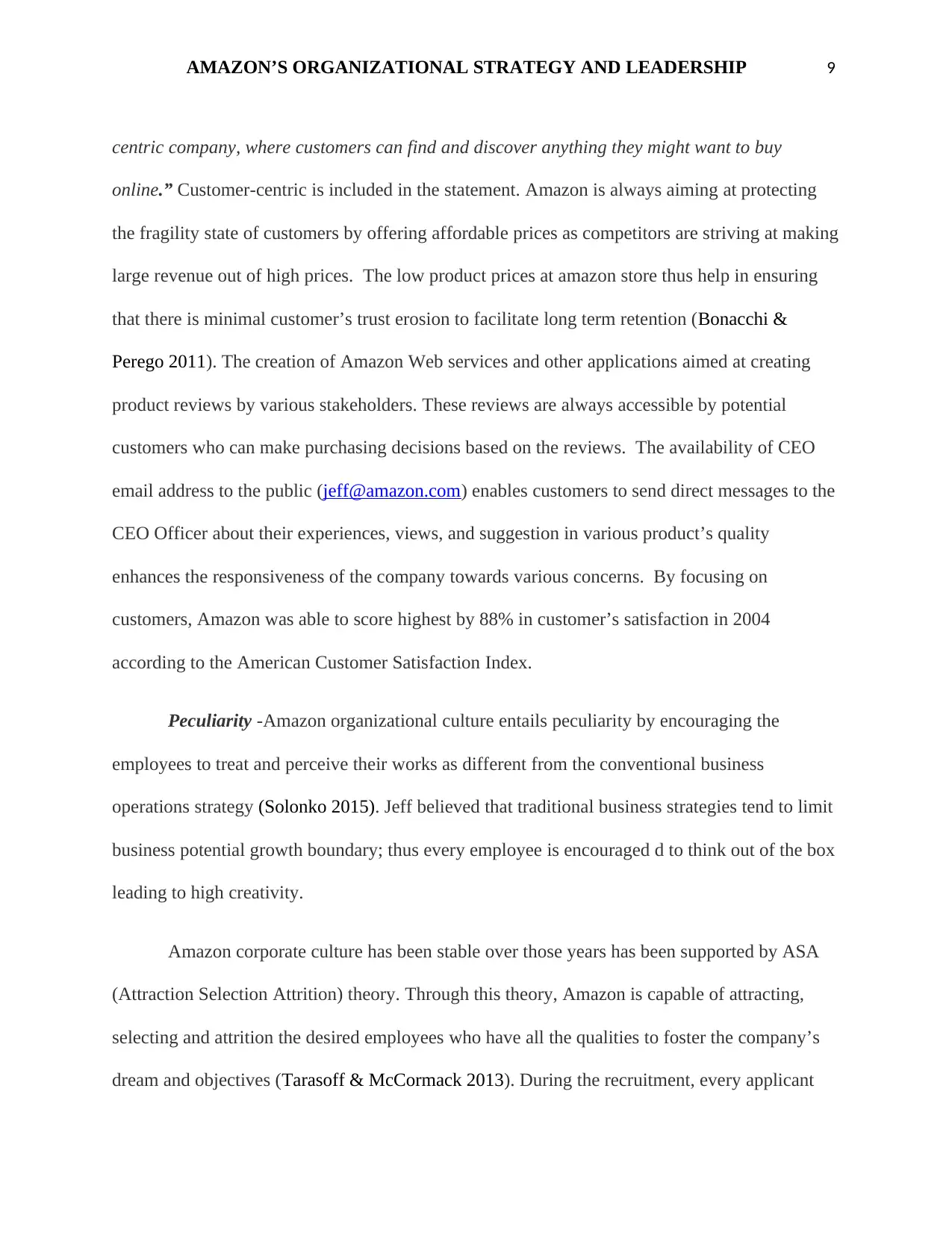
AMAZON’S ORGANIZATIONAL STRATEGY AND LEADERSHIP 9
centric company, where customers can find and discover anything they might want to buy
online.” Customer-centric is included in the statement. Amazon is always aiming at protecting
the fragility state of customers by offering affordable prices as competitors are striving at making
large revenue out of high prices. The low product prices at amazon store thus help in ensuring
that there is minimal customer’s trust erosion to facilitate long term retention (Bonacchi &
Perego 2011). The creation of Amazon Web services and other applications aimed at creating
product reviews by various stakeholders. These reviews are always accessible by potential
customers who can make purchasing decisions based on the reviews. The availability of CEO
email address to the public (jeff@amazon.com) enables customers to send direct messages to the
CEO Officer about their experiences, views, and suggestion in various product’s quality
enhances the responsiveness of the company towards various concerns. By focusing on
customers, Amazon was able to score highest by 88% in customer’s satisfaction in 2004
according to the American Customer Satisfaction Index.
Peculiarity -Amazon organizational culture entails peculiarity by encouraging the
employees to treat and perceive their works as different from the conventional business
operations strategy (Solonko 2015). Jeff believed that traditional business strategies tend to limit
business potential growth boundary; thus every employee is encouraged d to think out of the box
leading to high creativity.
Amazon corporate culture has been stable over those years has been supported by ASA
(Attraction Selection Attrition) theory. Through this theory, Amazon is capable of attracting,
selecting and attrition the desired employees who have all the qualities to foster the company’s
dream and objectives (Tarasoff & McCormack 2013). During the recruitment, every applicant
centric company, where customers can find and discover anything they might want to buy
online.” Customer-centric is included in the statement. Amazon is always aiming at protecting
the fragility state of customers by offering affordable prices as competitors are striving at making
large revenue out of high prices. The low product prices at amazon store thus help in ensuring
that there is minimal customer’s trust erosion to facilitate long term retention (Bonacchi &
Perego 2011). The creation of Amazon Web services and other applications aimed at creating
product reviews by various stakeholders. These reviews are always accessible by potential
customers who can make purchasing decisions based on the reviews. The availability of CEO
email address to the public (jeff@amazon.com) enables customers to send direct messages to the
CEO Officer about their experiences, views, and suggestion in various product’s quality
enhances the responsiveness of the company towards various concerns. By focusing on
customers, Amazon was able to score highest by 88% in customer’s satisfaction in 2004
according to the American Customer Satisfaction Index.
Peculiarity -Amazon organizational culture entails peculiarity by encouraging the
employees to treat and perceive their works as different from the conventional business
operations strategy (Solonko 2015). Jeff believed that traditional business strategies tend to limit
business potential growth boundary; thus every employee is encouraged d to think out of the box
leading to high creativity.
Amazon corporate culture has been stable over those years has been supported by ASA
(Attraction Selection Attrition) theory. Through this theory, Amazon is capable of attracting,
selecting and attrition the desired employees who have all the qualities to foster the company’s
dream and objectives (Tarasoff & McCormack 2013). During the recruitment, every applicant
⊘ This is a preview!⊘
Do you want full access?
Subscribe today to unlock all pages.

Trusted by 1+ million students worldwide
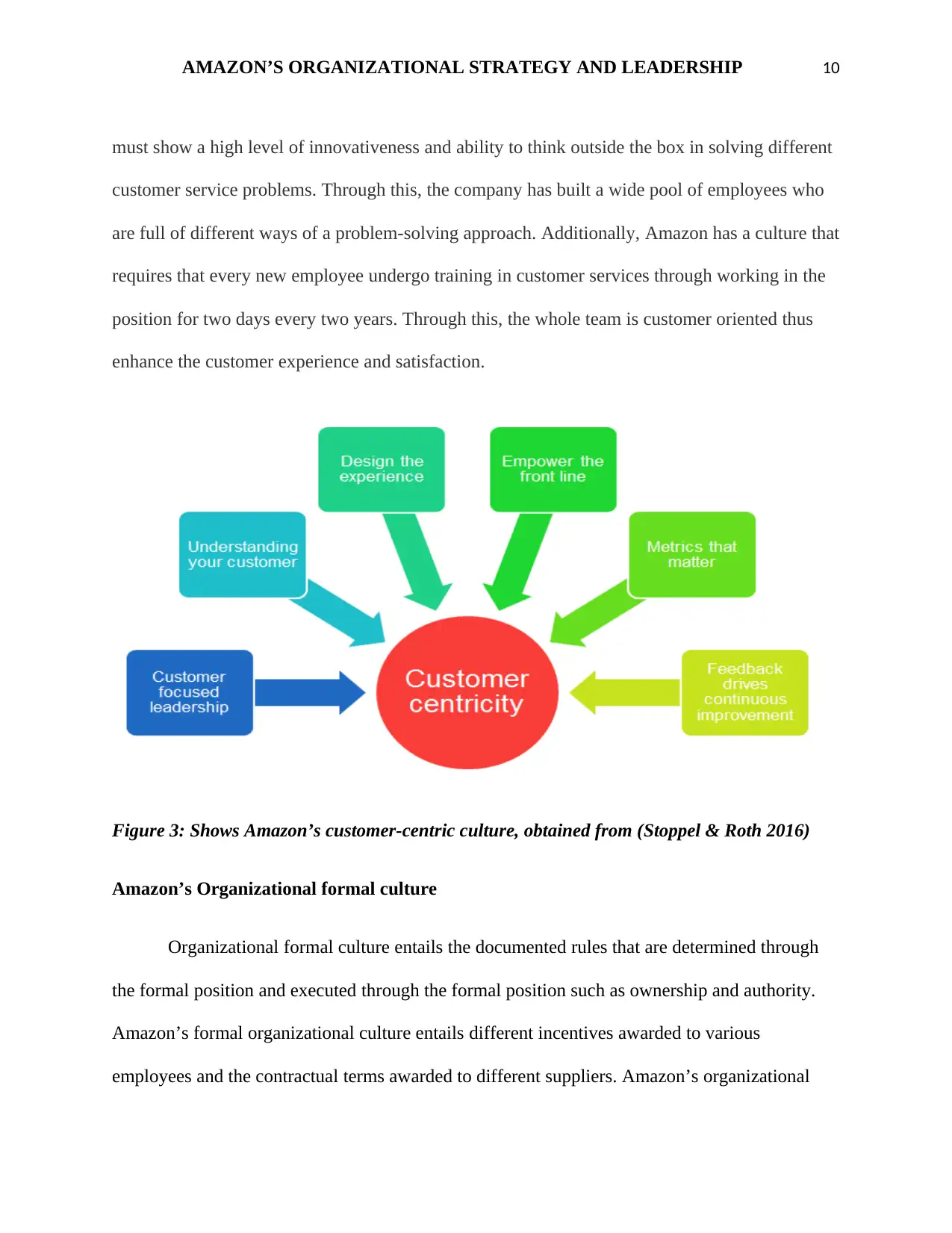
AMAZON’S ORGANIZATIONAL STRATEGY AND LEADERSHIP 10
must show a high level of innovativeness and ability to think outside the box in solving different
customer service problems. Through this, the company has built a wide pool of employees who
are full of different ways of a problem-solving approach. Additionally, Amazon has a culture that
requires that every new employee undergo training in customer services through working in the
position for two days every two years. Through this, the whole team is customer oriented thus
enhance the customer experience and satisfaction.
Figure 3: Shows Amazon’s customer-centric culture, obtained from (Stoppel & Roth 2016)
Amazon’s Organizational formal culture
Organizational formal culture entails the documented rules that are determined through
the formal position and executed through the formal position such as ownership and authority.
Amazon’s formal organizational culture entails different incentives awarded to various
employees and the contractual terms awarded to different suppliers. Amazon’s organizational
must show a high level of innovativeness and ability to think outside the box in solving different
customer service problems. Through this, the company has built a wide pool of employees who
are full of different ways of a problem-solving approach. Additionally, Amazon has a culture that
requires that every new employee undergo training in customer services through working in the
position for two days every two years. Through this, the whole team is customer oriented thus
enhance the customer experience and satisfaction.
Figure 3: Shows Amazon’s customer-centric culture, obtained from (Stoppel & Roth 2016)
Amazon’s Organizational formal culture
Organizational formal culture entails the documented rules that are determined through
the formal position and executed through the formal position such as ownership and authority.
Amazon’s formal organizational culture entails different incentives awarded to various
employees and the contractual terms awarded to different suppliers. Amazon’s organizational
Paraphrase This Document
Need a fresh take? Get an instant paraphrase of this document with our AI Paraphraser
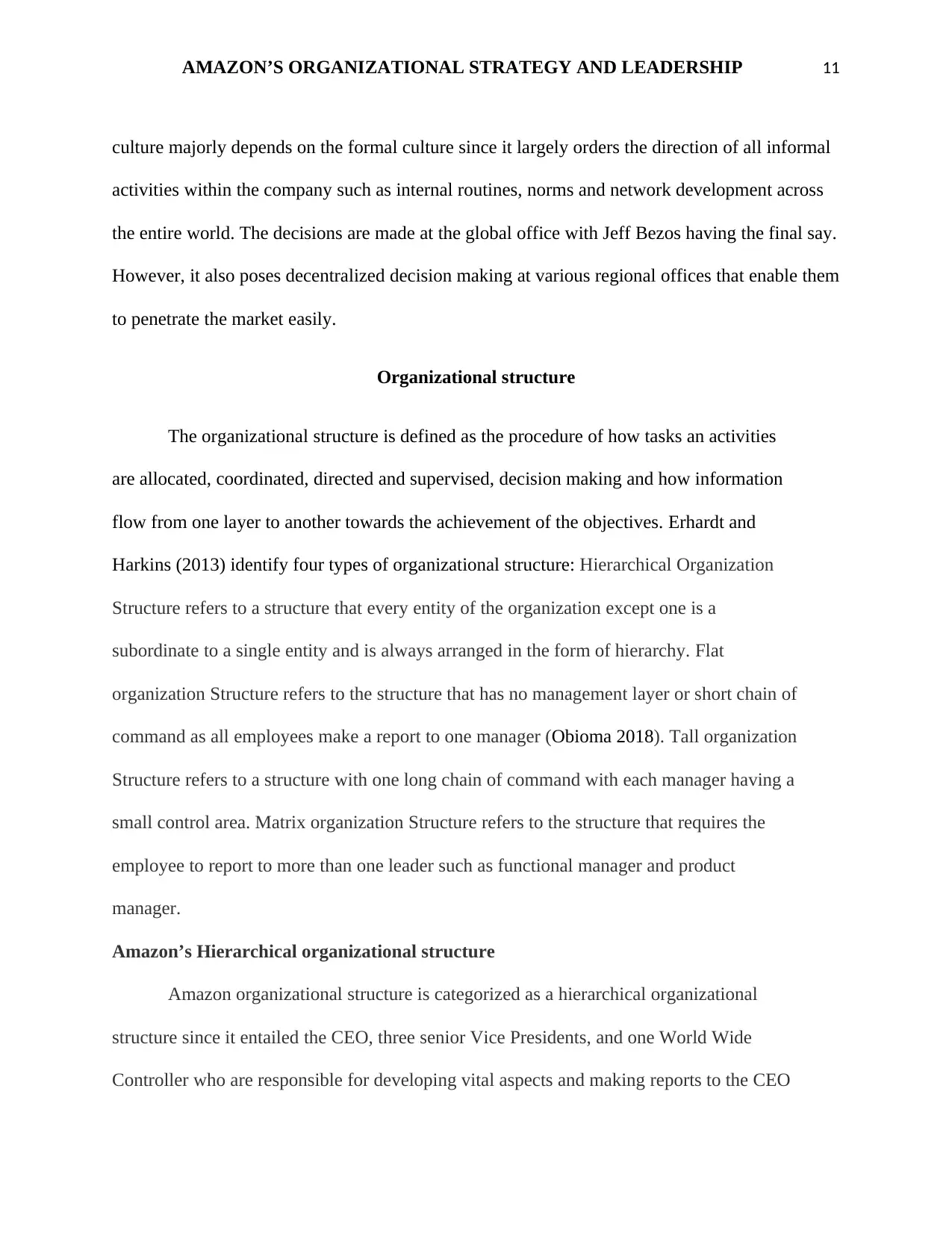
AMAZON’S ORGANIZATIONAL STRATEGY AND LEADERSHIP 11
culture majorly depends on the formal culture since it largely orders the direction of all informal
activities within the company such as internal routines, norms and network development across
the entire world. The decisions are made at the global office with Jeff Bezos having the final say.
However, it also poses decentralized decision making at various regional offices that enable them
to penetrate the market easily.
Organizational structure
The organizational structure is defined as the procedure of how tasks an activities
are allocated, coordinated, directed and supervised, decision making and how information
flow from one layer to another towards the achievement of the objectives. Erhardt and
Harkins (2013) identify four types of organizational structure: Hierarchical Organization
Structure refers to a structure that every entity of the organization except one is a
subordinate to a single entity and is always arranged in the form of hierarchy. Flat
organization Structure refers to the structure that has no management layer or short chain of
command as all employees make a report to one manager (Obioma 2018). Tall organization
Structure refers to a structure with one long chain of command with each manager having a
small control area. Matrix organization Structure refers to the structure that requires the
employee to report to more than one leader such as functional manager and product
manager.
Amazon’s Hierarchical organizational structure
Amazon organizational structure is categorized as a hierarchical organizational
structure since it entailed the CEO, three senior Vice Presidents, and one World Wide
Controller who are responsible for developing vital aspects and making reports to the CEO
culture majorly depends on the formal culture since it largely orders the direction of all informal
activities within the company such as internal routines, norms and network development across
the entire world. The decisions are made at the global office with Jeff Bezos having the final say.
However, it also poses decentralized decision making at various regional offices that enable them
to penetrate the market easily.
Organizational structure
The organizational structure is defined as the procedure of how tasks an activities
are allocated, coordinated, directed and supervised, decision making and how information
flow from one layer to another towards the achievement of the objectives. Erhardt and
Harkins (2013) identify four types of organizational structure: Hierarchical Organization
Structure refers to a structure that every entity of the organization except one is a
subordinate to a single entity and is always arranged in the form of hierarchy. Flat
organization Structure refers to the structure that has no management layer or short chain of
command as all employees make a report to one manager (Obioma 2018). Tall organization
Structure refers to a structure with one long chain of command with each manager having a
small control area. Matrix organization Structure refers to the structure that requires the
employee to report to more than one leader such as functional manager and product
manager.
Amazon’s Hierarchical organizational structure
Amazon organizational structure is categorized as a hierarchical organizational
structure since it entailed the CEO, three senior Vice Presidents, and one World Wide
Controller who are responsible for developing vital aspects and making reports to the CEO
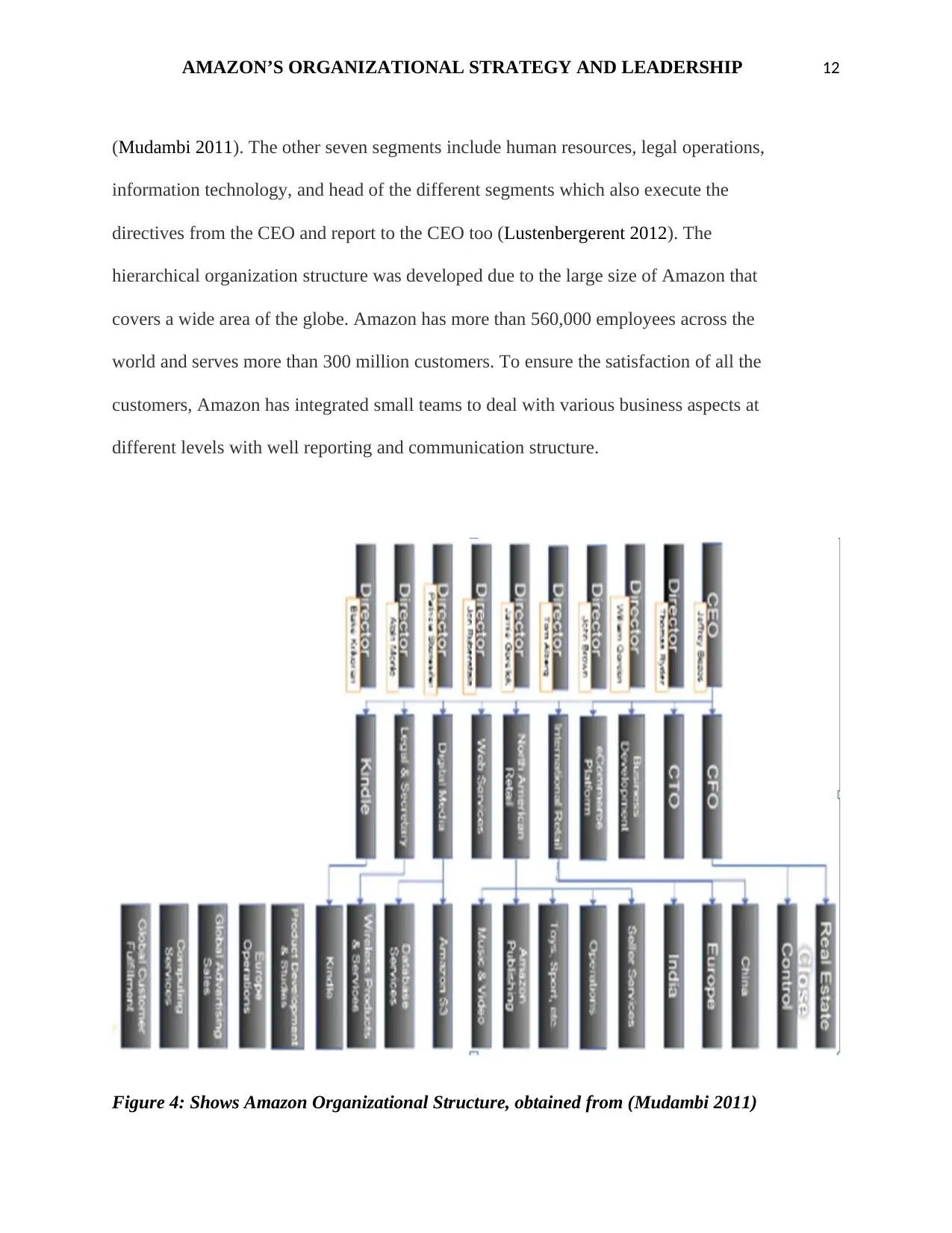
AMAZON’S ORGANIZATIONAL STRATEGY AND LEADERSHIP 12
(Mudambi 2011). The other seven segments include human resources, legal operations,
information technology, and head of the different segments which also execute the
directives from the CEO and report to the CEO too (Lustenbergerent 2012). The
hierarchical organization structure was developed due to the large size of Amazon that
covers a wide area of the globe. Amazon has more than 560,000 employees across the
world and serves more than 300 million customers. To ensure the satisfaction of all the
customers, Amazon has integrated small teams to deal with various business aspects at
different levels with well reporting and communication structure.
Figure 4: Shows Amazon Organizational Structure, obtained from (Mudambi 2011)
(Mudambi 2011). The other seven segments include human resources, legal operations,
information technology, and head of the different segments which also execute the
directives from the CEO and report to the CEO too (Lustenbergerent 2012). The
hierarchical organization structure was developed due to the large size of Amazon that
covers a wide area of the globe. Amazon has more than 560,000 employees across the
world and serves more than 300 million customers. To ensure the satisfaction of all the
customers, Amazon has integrated small teams to deal with various business aspects at
different levels with well reporting and communication structure.
Figure 4: Shows Amazon Organizational Structure, obtained from (Mudambi 2011)
⊘ This is a preview!⊘
Do you want full access?
Subscribe today to unlock all pages.

Trusted by 1+ million students worldwide
1 out of 21
Related Documents
Your All-in-One AI-Powered Toolkit for Academic Success.
+13062052269
info@desklib.com
Available 24*7 on WhatsApp / Email
![[object Object]](/_next/static/media/star-bottom.7253800d.svg)
Unlock your academic potential
Copyright © 2020–2025 A2Z Services. All Rights Reserved. Developed and managed by ZUCOL.





